The colors of British cats
- Marina Ulyanova
- Apr 18, 2019
- 14 min read
Nowadays there is a huge variety of colors of British cats. Today there are more than 250 different colors of British cats and it is not the limit.
Classic British cats – of blue monochrome color came along the breed from the very beginning, and some rare and exotic color were derived by breeders with a lot of hard work. Very rare combinations of colors and shades are highly valued among professional breeders and felinologists as well as among those who just love the breed. To keep the variety of colors in order they all are organized by types and groups depending on the main color, pattern and the colors of shading.
Every color has its own standards and characteristics. The process of color formation is quite complicated and some factors play the big part in it – for example genetics, predisposition of parents, or the fact of how dominant the color is or how the colors of parents are compatible with each other, the facts that one or both parents can be the carrier of some color genes are also very important. That is why all these factors are strongly considered and looked at and only the partners which fully match are selected for breeding.

The color of a British cats is defined not only by the color of the coat. Every color is defined by the following characteristics:
Color of the coat
Color of the undercoat
Pattern of the fur (if any present)
Eye color
Color of paw pads
Color of the tip of the nose
The main categories of colors of British cats:
Solid colors
Tortie colors
Color point
Silver colors
Golden colors
Tabby colors
Tipped colors (smoke, shaded, shell)
Colors with white – bi-colors, tri-colors (calico), mitted, harlequin, van
Let’s look at every group in detail.
=Solid Colors=
Every color is beautiful in its own way. You can’t say that this color is more beautiful than the other. Solid colors are monochrome, the color is distributed equally throughout the whole body, without any spots, stripes, patterns or white hairs, every piece of hair should be colored from the very root to the very tip. The look and feel of the coat are plush, thick and soft. The classic solid colors are blue and lilac. Black, chocolate and cream colors are rarer. Also, it is not easy to find cats of red color. The rarest and genetically more interesting solid colors are cinnamon and fawn ( at first glimpse these colors look a lot like chocolate and lilac and only expert can see the difference, in some cases only by taking genetic test).
Blue Color
It is classic and most common color of British cats. Most likely a cat of such color comes to mind when you think of British cat. Sometimes people call them grey British cat, British cat of grey color – technically it is a grey color but the right definition is blue. The coat of this color should be solid (monochrome), while the undercoat may be slightly lighter than the main color, but whitish hairs are not acceptable. Brighter blue color if more valuable. It is allowed for kittens to have some stripes, which disappear over time. The color of the iris of British kittens is gray or blue, but with aging it turns into saturated amber. The eye color of blue British cats can be copper, bright golden, amber (orange). The paw pads as well as the tip of the nose should be only blue.
Lilac color
Lilac British cat. It is another very common and popular color. Lilac is a combination of gray, pink and blue colors and it looks like clarified chocolate. The nose of the animal as well as the paw pads, correspond to the tone of the coat. Eyes are orange-copper colors. Lilac color is present in different variations: from cold lavender, to warm pink-gray. The undercoat of cats of a given color can be slightly lighter in color than the outer coat, but standout contrast is not acceptable. Very often kittens often have a residual pattern (moire), which disappears with age. The look of coat of a lilac British cat resembles a blue mink coat, the color of which is mixed with a little bit of pink paint. The nose, the paw pads and the eye contours have pink mauve shade, which becomes darker over time.
Black Color
This is a rare color. It is difficult to breed and many breeders call it "whimsical." It happens very often that a kitten born black changes its coat color to chocolate with age. Pigmentation of coat, undercoat and skin is saturated. The color of the undercoat and main coat should not differ. It is believed that the fewer light-colored ancestors in the pedigree, the richer and blacker the color will be. The coat often feels rougher than the coat of classic blues. The paw pads and the tip of nose are black. The eyes are copper, orange or golden color.
White color
The white coat of such cats should be clear, without yellowness or smoky tones, without stripes or spots. The paw pads and tip of nose should be pink. There are eye color variations – eyes can be light or dark blue, yellow or orange, or of different colors. Interesting fact that the name “white” is actually not the name of color but its absence that is why in the category of solid colors white color is always put separately. It is very difficult to breed this color and there is a high risk of breeding cats with health issues. For example, very often white colored kittens with blue eyes are born deaf because the gene of this color is linked with genes of hearing. And it is highly possible that white colored cats with eyes of different colors will be deaf in one ear. It is not allowed to mate two cats of solid white colors because of a high probability of the appearance of offspring with deafness.
Red (red, gold) color
The red color of the British cats was introduced from Persian cats and other exotic breeds of cats with red color of coat. Very often these cats have tabby marks on their foreheads and paws. The eyes of red British cats are rich orange color or copper. The color of their nose and paw pads is red, brick color. A significant disadvantage of British cats of red color is the uneven color distribution, so very often the tip of cat’s tail has lighter coloring. It is extremely difficult to find a British cat of a very solid and even red color. That is why some small tabby pattern is allowed by standards.
Cream color
This color is a diluted red color, which happens when dilute white gene is present. This shade of coat belongs to the oldest types of solid colors, however recently it has become quite rare in breeding. Cream colored British cats should have a clear and soft (pastel) shade, intense color, and color i.e. "Hot" cream is considered a flaw. In kittens tabby pattern is seen and residual tabby marks are allowed for adult cats. The nose and paw pads are pink. The eye color can be orange, golden or copper. The feel and quality of coat of cream colored British cats is the same as classic blue and lilac.
Chocolate color
This color should be rich and deep, the darker the color the better. This color is also called havana color or chestnut.
In these latter days breeders as a result of very strict selection process have achieved very high quality of coat in cats of this color, which is equal to quality in classic blue British cats. The fur of cream cats looks like mouton fur. White hairs or hairs of other colors are not acceptable. By standards all the shades of chocolate color are accepted – from light milk chocolate to dark chocolate. The eyes can be either dark orange or copper, saturated colors are valued more. The tip of nose as well as paw pads should have the same color as the color of the coat – chocolate or chestnut. The process of full color formation takes a long time 1-1,5 years.
Cinnamon color
It is pretty rare and highly valued color. The color is very similar to diluted chocolate but it is a very warm and soft chocolate which has copper or bronze undertone. The kittens of this color are born very rarely because the color coat gene is recessive. The eyes are orange or copper. Cinnamon colored cats ALWAYS have pink colored tip of nose and paws pads, if they are light brown or have milk chocolate color this is not a cinnamon colored cat.
Fawn color
Fawn is another extremely rare and exotic color which is so desirable and highly valued amog breeders. It is even more diluted cinnamon color, looks like burnt cinnamon. It is very beautiful, soft, elegant color. The tip of nose and paw pads should be pink.
Officially as an independent color it was recognized only in 2006.The color is very interesting for breeders because of the possibility of deriving even more diluted colors. Fawn kittens can be born only if both parents are carriers of fawn color gene. Only DNA tests confirm if a cat is a carrier of fawn color gene. Species with similar but not confirmed color are referred to as blue, cream, or rejected.
=Tortie Colors=
Tortoiseshell color is the combination of spots of solid color which leave a mosaic pattern on the cat's hair in various combinations. Intense solid colors like black, chocolate and cinnamon, combine with red, on the other hand diluted lighter colors - lilac, fawn and blue - with cream. This type of coat coloring is possible only in cats.
Tortie color takes its time to develop fully. A newborn kitten might have just a few color spots, but with age the number of them will increase. Young adults have a gray undercoat or a slightly diluted red tint, but the final color is formed over a year.
Tortoiseshell cats are rightfully considered the queens and kings of any cattery, because they can produce offsprings of various colors.
The main tortie colors are classic ones:
Black Tortie color (Black+Red) - This is a harmonious combination of proportional red and black specks of different shades. The hairs are colored evenly. Black color should be saturated, and red, respectively, should be bright and intense. Both colors should be present on the paws and head of the black tortie British cats. Mixed specks are allowed by the standard. A red "tongue of flame" (tan) on the face is desirable. It might seem that besides red there is a cream color present but indeed it is diluted red. The presence of patterns on the red spots is not desirable.
Chocolate Tortie color (Chocolate+Red)
It is a combination of chocolate and red colors in identical proportions of a mosaic. General requirements are the same as in the previous case: intense, saturated color, harmonious distribution, evenly colored hairs, tan on the muzzle and the absence of any pattern. It is considered correct if both colors - chocolate as we as red - are present on the muzzle and paw pads. Kittens may have not as much saturated and bright color but the color will be more intense and bright by the age of 1 year.
Blue Tortie color (Blue+Cream)
This color combines the blue and cream spotted pattern, specks also should be proportional. This color is very soft and warm and the contrast between two colors is not as obvious as in other tortie colors. The overall tone of this color can be as light cream or medium blue. It is highly desirable if there is a cream tan present of the muzzle. Any tabby patterns or white hairs should not be present.
Cinnamon Tortie color (Cinnamon+Red)
This is the combination of color spots of cinnamon and red shades on the coat. The color coat is very soft and warm but saturated. Color requirements are the same as for black and chocolate torties. Both colors should be present in equal proportions, every hair is colored evenly from root to tip, no tabby patters or residual white hairs are allowed. As for all torties the presence of red color of the muzzle and paw pads is very important. It is extremely rare color and is highly valued among breeders.
Lilac Tortie color (Lilac+Cream)
It is another color which is hard to find. This is a uniform combination of lilac and cream colors, both colors spread evenly throughout the body. Both colors should be very clear without any tabby patterns (spots, stripes or marble) or white hairs. The tone of overall color is pretty bright and soft, that is why breeders like this color so much. Cream tan near the nose and on the paw pads is highly desirable. Lighter colors are valued more but there is shouldn’t be too much of cream tone present.
Fawn Tortie color (Fawn+Cream)
This is the combination of fawn color and cream spots. It is a very unique and harmonious color which is very soft and light. British cats of fawn tortie colors same as solid fawn colors are very rare, they have great quality of coat. The standard requirements are the same as for the other tortoiseshell colors of the British cats – even color distribution, no tabby pattern or white hairs, a cream tan on the muzzle and paw pads are highly desirable.
Tortie colors described above are just main classic tortie colors. There is a big variety of tortie colors. Some of them are:
- Smoke Tortie colors which represent a combination of coat of classic tortie colors with smoke - lighter colored undercoat hair of silver color colored at the roots. At first glimpse it is barely possible to see a difference between smoke tortie and classic tortie. You will need to look close at the hair of the undercoat by spreading it apart. When you look at smoke tortie cat you get an impression that cats coat is not very bright but a little bit diffused or blurred. It happens because of presence of smoke in the undercoat. The overall color looks more harmonious because smoke blurs the contrast between two colors. Depending on the tortie color the tip of nose and paw pads can be black, pink, cream , brown, blue and etc. There are smoke black tortie, smoke chocolate tortie, smoke blue tortie, smoke fawn tortie, smoke cinnamon tortie, smoke lilac tortie colors.
- Torbie Colors ( Tabby Tortie color) -is a combination of classic tortie color with tabby pattern. Torbie is BLACK (or other diluted color) + RED (or cream) + TABBY pattern. The pattern can be represented by spots, stripes or marble pattern. There is a great variety of torbie colors.
Tortie colors can be found in calico (bi-color) or tri-color variations, tortie with white, torbie with white, tortie color point as well.
=Color Points=
(Siamese/Himalayan Colors)
The color of British cats of the color-point type is distinguished by special color marks.
British cats inherited this unusually attractive type of color from Siamese and Himalayan cats. Coloring is the most intense on the remote areas of cat body – ears, tail and paws, on the other body parts coloring is lighter, but not pure white. There should be any patterns or spots and stripes present. The coat is very dense, the undercoat is white.
The areas with concentration of pigment (markings) are called “points”, and the overall color in relation to the main body is called color point. The gene of Siamese color is recessive and in order for it to appear in the future, both parents must carry it. Also, the gene is linked to a blue color of the eyes. Eye color can be light blue or dark blue. The more intense blue color of the eyes the better. It is difficult to breed British color-point cats. Kittens are born pure white or close to white, so in the photo it is difficult to tell a color point kitten apart from all other kittens Markings begin to come out over time.
Siamese color gene can be combined with all colors of the British breed. If it is mixed with solid colors, then it is called color-point, in combination with tabby-colors it is links-point, and the combination of the pattern on points with silver has the name silver links-point, and if combined with the shaded colors it is called shaded point, accordingly.
Solid color points are characterized by a diamond-shaped coloring of the face, and the color of the markings should be of the same color with pronounced boundaries on the transitions. The rest of the body has light coloring, and the lighter the better. The facial mask should not in any way spread to the back of the head. The color of the pads of paws and the nose fully match the color of the marks.
There are several main groups of color points: - Classic color point
- Bi-color color point
- Silver (smoke) color points
- Tabby color point
- Tortie color points
- Shaded and Shell color points
Classic Color Points
The number of classic color points correspond the number of main solid colors – blue point, chocolate point, seal point, cream point, lilac point, fawn point, red point, cinnamon point. The overall coloring consists of point of main solid color on light bright base. These colors are still quite rare but arouse a lot of interest among breeders. The main standards are: the hair is short and dense, the contrast is very obvious, the hairs on muzzle, ears, paws and tail are colored from tip to end. Point markings should be very clear, without any blur and have saturated coloring. There should not be any white hair spotted on the markings. The eye color is light or dark blue. The more saturated blue color is the better.
Tortie Color Points
Tortie color point is a very interesting mixed color which combines 2 colors - color point and tortie. In short words you can call it Siamese British cat mixed a little bit with tortie. The body of a cat is light color and its ears, muzzle, paws and tail have a color represented by tortie mosaic coloring. It is highly desirable when there are no very clear or big spots of red or black colors. Such kittens can be born only if one of the parents is tortie and another one is color point which happens very rarely. That is why tortie color points are highly valued colors.
Bi-Color Color Points
This type of coloring in British breed is extremely rare. It combines two colors - color point and "dressy" bi-color coloring. There are certain standards of these colors as well which should be met. British bi-color color point cat should have facial mask, ears, paws (back) and tail which have darker coloring, should have white spots in the muzzle ( in the cheek area where whiskers and nose are located). Front paws most of the times should be white. White part should color from 1/2 to 1/3 of cat body. Overall coloring should look harmonious.
Eyes are dark or light blue. Paw pads and tip of nose have the same main solid color. There are the following bi-color color points:
- Seal point bi-color
- Blue point bi-color
- Chocolate point bi-color
- Lilac point bi-color
- Cinnamon point bi-color
- Fawn point bi-color
- Red point bi-color
- Cream point bi-color
Tabby Color Points
(Lynx)
Cats of this color have a distinguished tabby pattern on the points of color: letter "M", pattern around the eyes, distinguished spots in the whiskers area, spotted marks on ears. The hairs on the main body are bright and light. On the front legs there is a pattern which looks like open rings, going upwards from the very paws. There are stripes on the hips. The colors of paw pads and the tip of nose match the the colors of pattern. Tabby color points are represented in all variety of colors in which only color points and tortie colors can be presented.
Silver ( Smoke) Color Points
Not often you can find a cat of smoke color point coloring. This color looks very unusual and creates some sort of mysterious look.
Smoke color point cats have mixed color, and the standards of each color should be completely met. Smoke color point cats should have light coloring on the most of the hair on their body and some darker areas on some body parts : face, ears, legs and paws, there should be obvious smoke coloring on the ears. The undercoat should be white. There should not be any tabby pattern. Blue eyes. The tip of nose and paw pads are of the main solid color.
Shaded and Shell (Chinchilla) Color Points
The shading of a coat can be formed either on a base of silver or gold and tipping ( tip of a single piece of hair) on the back of a cat has the main color which covers 1/3 of a piece of hair. Besides that the muzzle, ears and tail are shaded as well. The tip of nose and eyeliner have the main color (blue, black, red etc.). The color of eyes is blue. The color of paw pads should correspond the main color.
Tabby pattern is considered a flaw.
It is very hard to tell shell (chinchilla) point apart from regular chinchilla color on the base of silver. The main difference is the eye color - chinchillas have green eyes and chinchilla color points have eyes of blue color.
The shading of a coat can be formed either on a base of silver or gold and tipping on the back has the main color which covers 1/8 of a piece of hair. Also the tipping on the back of color point chinchillas is diluted in relation to points. For example, brown is diluted to beige, red is diluted to pale yellow.
Color point chinchillas on the base of gold are still extremely rare. There are not many cats of this color in the world and the standards are still being established.
Tabby pattern is not acceptable.
.......The post is to be continued.......


















































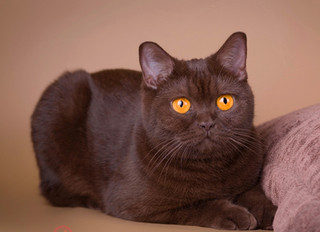

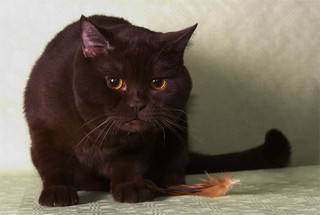



















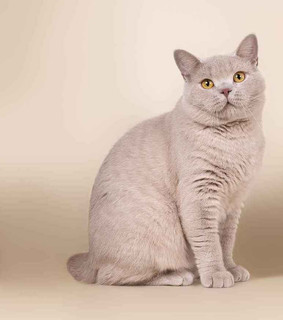






















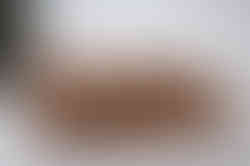









































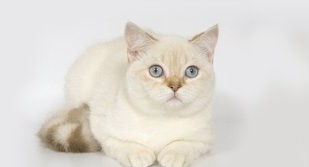





















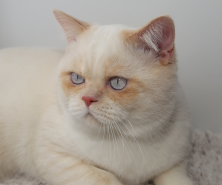





































































I've always wanted one of my own British cats. I was wondering - should I feed my new British cat special food? Do they need any different care than other cats? cat distribution system